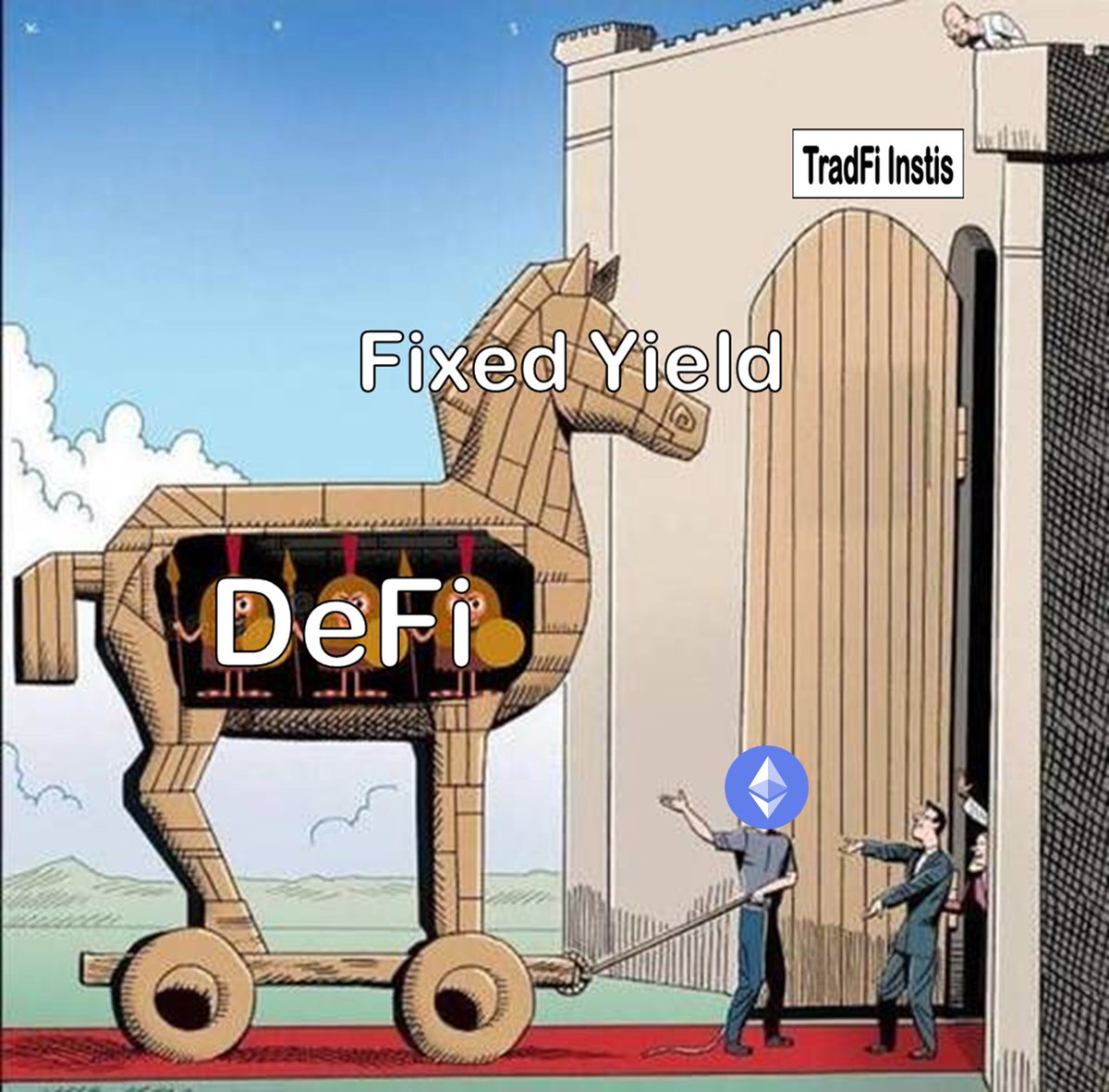0/ Fixed yield will be DeFi’s Trojan horse for TradFi.
Predictable cashflows. Certainty in the face of uncertainties.
It’s a language institutions already understand and love - now enforced by code and settled on @Ethereum.
A guest thread by @tn_pendle.
Predictable cashflows. Certainty in the face of uncertainties.
It’s a language institutions already understand and love - now enforced by code and settled on @Ethereum.
A guest thread by @tn_pendle.

1/ Variable yields can often be higher, but have no guarantee of actual performance. Even active strategies are invariably exposed to market fluctuations.
That’s why fixed yields anchor most portfolios: predictable returns that preserve wealth and compound growth.
That’s why fixed yields anchor most portfolios: predictable returns that preserve wealth and compound growth.
2/ While the DeFi-TradFi convergence has recently surged, it remains largely entrenched in legacy metrics.
But the key to wooing institutions isn’t flashy APYs - it’s to meet them where they’re already comfortable.
But the key to wooing institutions isn’t flashy APYs - it’s to meet them where they’re already comfortable.
3/ In traditional markets, this $33.2T role is filled by T-Bills that earn a meagre 3-5% APY.
On Ethereum, this number can go up to 8-15% Fixed APY, comparable with CCC-rated high risk bonds (~12%).
On Ethereum, this number can go up to 8-15% Fixed APY, comparable with CCC-rated high risk bonds (~12%).
4/ The difference is that fixed yield on Ethereum doesn’t rely on distressed issuers or opaque IOUs.
It’s enforced by code and settled onchain.
It’s enforced by code and settled onchain.
5/ For institutions, this is the kind of structure that resonates.
There’s no need to speculate on yields.
There’s no need to trade-off risk and reward.
It’s all packaged in a familiar product supported by the composability, transparency, and security of Ethereum.
There’s no need to speculate on yields.
There’s no need to trade-off risk and reward.
It’s all packaged in a familiar product supported by the composability, transparency, and security of Ethereum.
6/ All these are powered by a little DeFi magic called “yield trading”.
The premise is simple, take any yield-bearing asset and split it:
YT = the yield stream
PT = the principal
Which is akin to splitting a bond into coupon and principal, a familiar territory to institutions.
The premise is simple, take any yield-bearing asset and split it:
YT = the yield stream
PT = the principal
Which is akin to splitting a bond into coupon and principal, a familiar territory to institutions.
7/ By trading PT and YT separately, you unlock new ways to manage, hedge, and amplify yield.
And yes, that includes our “Fixed Yield” Trojan Horse too. The TradFi playbook supercharged by DeFi 😉
This is essentially @pendle_fi in a nutshell.
And yes, that includes our “Fixed Yield” Trojan Horse too. The TradFi playbook supercharged by DeFi 😉
This is essentially @pendle_fi in a nutshell.
8/ 'Yield trading' isn't new. As with many of DeFi's innovations, similarities can be drawn with a TradFi equivalent.
As @aave, @MorphoLabs, @eulerfinance are to banks, and @Uniswap is to exchanges, Pendle is to the $400T+ interest rate swap market, all built on Ethereum.
As @aave, @MorphoLabs, @eulerfinance are to banks, and @Uniswap is to exchanges, Pendle is to the $400T+ interest rate swap market, all built on Ethereum.
9/ Where TradFi inspires DeFi, DeFi as an emergent technology is starting to receive institutional recognition.
The SEC's approval of the Ethereum ETF was our first landmark victory.
Our next goal is to bring onboard TradFi money into DeFi.
Transparent, reliable, and onchain.
The SEC's approval of the Ethereum ETF was our first landmark victory.
Our next goal is to bring onboard TradFi money into DeFi.
Transparent, reliable, and onchain.
10/ Four years ago, yield trading was a new, foreign idea in DeFi.
Since then, the market has scaled to $10B+ in TVL and $100M+ in daily volume, positioned to onboard the next wave of institutional clients.
Since then, the market has scaled to $10B+ in TVL and $100M+ in daily volume, positioned to onboard the next wave of institutional clients.
11/ Of this, over $54B in fixed yield derivatives have been successfully settled on Pendle, including $ETH derivatives, stablecoin, RWAs, etc.
Today, the fixed yield market on Ethereum is already a battle-tested, core financial infrastructure, with the potential for more growth.
Today, the fixed yield market on Ethereum is already a battle-tested, core financial infrastructure, with the potential for more growth.
12/ With the GENIUS Act passed and corporations like Walmart & Amazon exploring stablecoins, demand for stable, predictable onchain yield is only set to grow.
The goal is ultimately to meet the demand for certainty by institutions through innovations enabled by Ethereum.
The goal is ultimately to meet the demand for certainty by institutions through innovations enabled by Ethereum.
13/ Just as Treasuries anchor TradFi, fixed yield on Ethereum is shaping up to be the anchor for onchain finance.
The Trojan horse is here, and with it we can show the world that DeFi could be the next foundation for the next era of finance.
The Trojan horse is here, and with it we can show the world that DeFi could be the next foundation for the next era of finance.
• • •
Missing some Tweet in this thread? You can try to
force a refresh











